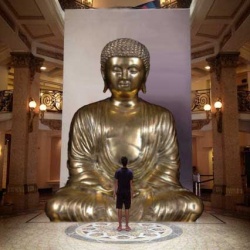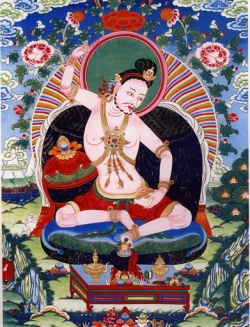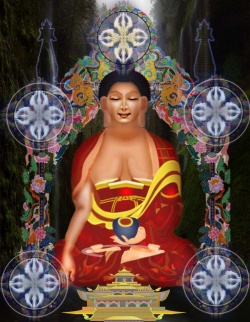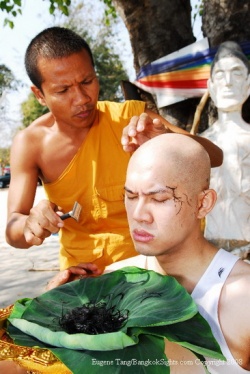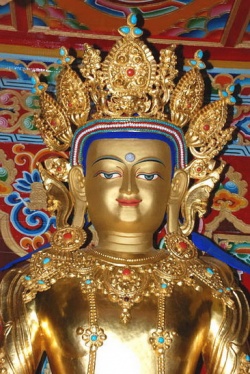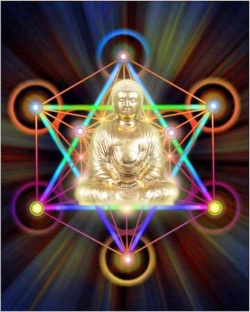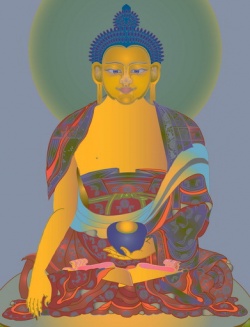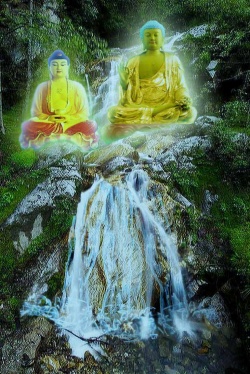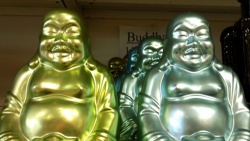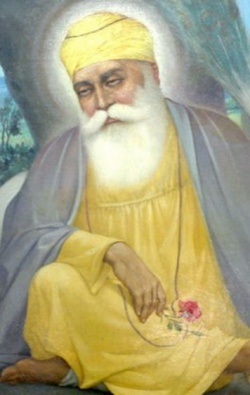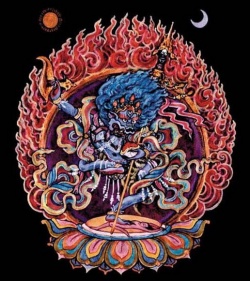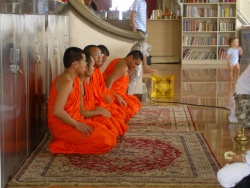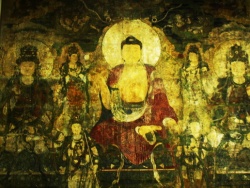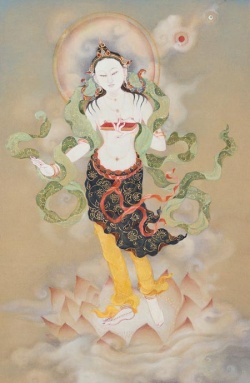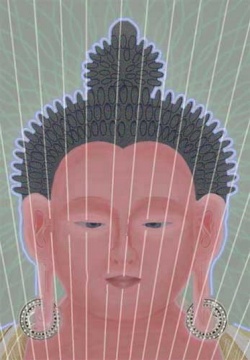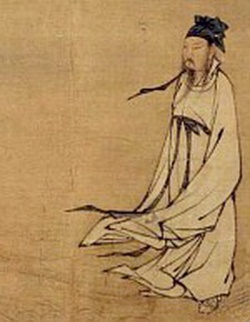Difference between revisions of "Tibetan Vajrayana Buddhist Pantheon"
| Line 1: | Line 1: | ||
| − | <nomobile>{{DisplayImages|3774|928|4238|2487|714|3919|1715|4369|3075|44|925|2322|1202|3134|1803|535 | + | <nomobile>{{DisplayImages|3774|928|4238|2487|714|3919|1715|4369|3075|44|925|2322|1202|3134|1803|535}}</nomobile> |
| − | This section of our site focuses on the Tibetan Vajrayana Buddhist Pantheon. Each of the deities here represents a unique spiritual personality or essence. The principal beings are the five Dhyani Buddhas- the esoteric meditation Buddhas of the five colors found in The Tibetan Book of the Dead and other sources. Contrary to popular belief, these deities are not Buddhist Gods, but rather different aspects of the one God. Among these are several teachers or gurus, who have attained notoriety and importance, and as such are venerated. | + | This section of our site focuses on the [[Tibetan]] [[Vajrayana]] [[Buddhist Pantheon]]. Each of the [[deities]] here represents a unique [[spiritual]] [[personality]] or [[essence]]. The [[principal]] [[beings]] are the [[five Dhyani Buddhas]]- the [[esoteric]] [[meditation]] [[Buddhas]] of the five colors found in The [[Tibetan Book of the Dead]] and other sources. Contrary to popular [[belief]], these [[deities]] are not [[Buddhist Gods]], but rather different aspects of the one [[God]]. Among these are several [[teachers]] or [[gurus]], who have [[attained]] notoriety and importance, and as such are venerated. |
| − | Like the Hindu Deities, these are meant to express particular aspects of the Infinite, and are are used as devotional images helping the seeker visualize, concentrate on, and thus in time attain, that aspect of the Infinite in him or herself. | + | Like the [[Hindu]] [[Deities]], these are meant to express particular aspects of the [[Infinite]], and are are used as devotional images helping the seeker [[visualize]], [[concentrate]] on, and thus in time attain, that aspect of the [[Infinite]] in him or herself. |
| − | The essence of each being is: | + | The [[essence]] of each being is: |
| − | First, of a spiritual personality describing his or her essential nature | + | First, of a [[spiritual]] [[personality]] describing his or her [[essential nature]] |
| − | Second, of an actor describing his or her role in the Vajrayana tradition, and the spiritual environment in which action takes place | + | Second, of an actor describing his or her role in the [[Vajrayana tradition]], and the [[spiritual]] {{Wiki|environment}} in which [[action]] takes place |
| − | Third, of a spiritual guide giving advice to the seeker | + | Third, of a [[spiritual guide]] giving advice to the seeker |
| − | The purpose is to introduce the spiritual seeker to elements of the Vajrayana Buddhist tradition outside the bounds of a particular lineage or school. When a Tibetan monk or nun is initiated into a Vajrayana lineage, he or she is often given a Yidam who serves as a spiritual guide, protector, and a focus of meditation. The practitioner meditates on the deity to forge a strong link with this inner guide and teacher. One of the beings listed below is often chosen as a Yidam or guide for the initiate. | + | The {{Wiki|purpose}} is to introduce the [[spiritual]] seeker to [[elements]] of the [[Vajrayana Buddhist tradition]] outside the bounds of a particular [[lineage]] or school. When a [[Tibetan]] [[monk]] or [[nun]] is [[initiated]] into a [[Vajrayana]] [[lineage]], he or she is often given a [[Yidam]] who serves as a [[spiritual guide]], [[protector]], and a focus of [[meditation]]. The [[practitioner]] [[meditates]] on the [[deity]] to forge a strong link with this inner guide and [[teacher]]. One of the [[beings]] listed below is often chosen as a [[Yidam]] or guide for the initiate. |
| − | One function of these guides is to inspire creativity, for they can serve as muses. However, their traditional role is that of a guide to the spiritual traveler who seeks knowledge of and access to the many inner worlds one may encounter during meditation. This kind of visionary experience is a stepping-stone to the ultimate Buddhist goal of liberation from suffering (enlightenment). | + | One function of these guides is to inspire {{Wiki|creativity}}, for they can serve as muses. However, their [[traditional]] role is that of a guide to the [[spiritual]] traveler who seeks [[knowledge]] of and access to the many inner [[worlds]] one may encounter during [[meditation]]. This kind of [[visionary]] [[experience]] is a stepping-stone to the [[Wikipedia:Absolute (philosophy)|ultimate]] [[Buddhist]] goal of [[liberation]] from [[suffering]] ([[enlightenment]]). |
| − | The contemplative images here can serve as maps describing the geography of the inner spiritual worlds. They can also familiarize the reader with the values and ideals of Buddhism and the Tibetan tradition. | + | The {{Wiki|contemplative}} images here can serve as maps describing the {{Wiki|geography}} of the inner [[spiritual]] [[worlds]]. They can also familiarize the reader with the values and ideals of [[Buddhism]] and the [[Tibetan tradition]]. |
| − | Tibetan Vajrayana Buddhist Pantheon | + | [[Tibetan]] [[Vajrayana]] [[Buddhist Pantheon]] |
| − | This section of our site focuses on the Tibetan Vajrayana Buddhist Pantheon. Each of the deities here represents a unique spiritual personality or essence. The principal beings are the five Dhyani Buddhas- the esoteric meditation Buddhas of the five colors found in The Tibetan Book of the Dead and other sources. Contrary to popular belief, these deities are not Buddhist Gods, but rather different aspects of the one God. Among these are several teachers or gurus, who have attained notoriety and importance, and as such are venerated. | + | This section of our site focuses on the [[Tibetan]] [[Vajrayana]] [[Buddhist Pantheon]]. Each of the [[deities]] here represents a unique [[spiritual]] [[personality]] or [[essence]]. The [[principal]] [[beings]] are the [[five Dhyani Buddhas]]- the [[esoteric]] [[meditation]] [[Buddhas]] of the five colors found in The [[Tibetan Book of the Dead]] and other sources. Contrary to popular [[belief]], these [[deities]] are not [[Buddhist Gods]], but rather different aspects of the one [[God]]. Among these are several [[teachers]] or [[gurus]], who have [[attained]] notoriety and importance, and as such are venerated. |
| − | Like the Hindu Deities, these are meant to express particular aspects of the Infinite, and are are used as devotional images helping the seeker visualize, concentrate on, and thus in time attain, that aspect of the Infinite in him or herself. | + | Like the [[Hindu]] [[Deities]], these are meant to express particular aspects of the [[Infinite]], and are are used as devotional images helping the seeker [[visualize]], [[concentrate]] on, and thus in time attain, that aspect of the [[Infinite]] in him or herself. |
| − | The essence of each being is: | + | The [[essence]] of each being is: |
| − | First, of a spiritual personality describing his or her essential nature | + | First, of a [[spiritual]] [[personality]] describing his or her [[essential nature]] |
| − | Second, of an actor describing his or her role in the Vajrayana tradition, and the spiritual environment in which action takes place | + | Second, of an actor describing his or her role in the [[Vajrayana tradition]], and the [[spiritual]] {{Wiki|environment}} in which [[action]] takes place |
| − | Third, of a spiritual guide giving advice to the seeker | + | Third, of a [[spiritual guide]] giving advice to the seeker |
| − | The purpose is to introduce the spiritual seeker to elements of the Vajrayana Buddhist tradition outside the bounds of a particular lineage or school. When a Tibetan monk or nun is initiated into a Vajrayana lineage, he or she is often given a Yidam who serves as a spiritual guide, protector, and a focus of meditation. The practitioner meditates on the deity to forge a strong link with this inner guide and teacher. One of the beings listed below is often chosen as a Yidam or guide for the initiate. | + | The {{Wiki|purpose}} is to introduce the [[spiritual]] seeker to [[elements]] of the [[Vajrayana Buddhist tradition]] outside the bounds of a particular [[lineage]] or school. When a [[Tibetan]] [[monk]] or [[nun]] is [[initiated]] into a [[Vajrayana]] [[lineage]], he or she is often given a [[Yidam]] who serves as a [[spiritual guide]], [[protector]], and a focus of [[meditation]]. The [[practitioner]] [[meditates]] on the [[deity]] to forge a strong link with this inner guide and [[teacher]]. One of the [[beings]] listed below is often chosen as a [[Yidam]] or guide for the initiate. |
| − | One function of these guides is to inspire creativity, for they can serve as muses. However, their traditional role is that of a guide to the spiritual traveler who seeks knowledge of and access to the many inner worlds one may encounter during meditation. This kind of visionary experience is a stepping-stone to the ultimate Buddhist goal of liberation from suffering (enlightenment). | + | One function of these guides is to inspire {{Wiki|creativity}}, for they can serve as muses. However, their [[traditional]] role is that of a guide to the [[spiritual]] traveler who seeks [[knowledge]] of and access to the many inner [[worlds]] one may encounter during [[meditation]]. This kind of [[visionary]] [[experience]] is a stepping-stone to the [[Wikipedia:Absolute (philosophy)|ultimate]] [[Buddhist]] goal of [[liberation]] from [[suffering]] ([[enlightenment]]). |
| − | The contemplative images here can serve as maps describing the geography of the inner spiritual worlds. They can also familiarize the reader with the values and ideals of Buddhism and the Tibetan tradition. | + | The {{Wiki|contemplative}} images here can serve as maps describing the {{Wiki|geography}} of the inner [[spiritual]] [[worlds]]. They can also familiarize the reader with the values and ideals of [[Buddhism]] and the [[Tibetan tradition]]. |
| − | ==The Five Dhyani Buddhas== | + | ==The [[Five Dhyani Buddhas]]== |
| − | (Tibetan: Gyalwa Rig.Nga) | + | ([[Tibetan]]: [[Gyalwa Rig.Nga]]) |
| − | The five Dhyani buddhas represent the basic mandala in ourselves, our environment and in the cosmos. All deities belong to one of these buddha families. Through their tantric practice negative energies and attitudes are transformed into enlightened wisdoms. | + | The five [[Dhyani buddhas]] represent the basic [[mandala]] in ourselves, our {{Wiki|environment}} and in the [[cosmos]]. All [[deities]] belong to one of these [[buddha families]]. Through their [[tantric practice]] negative energies and attitudes are [[transformed]] into [[enlightened]] [[wisdoms]]. |
<poem> | <poem> | ||
| − | The white father Vairocana transforms anger | + | The white father [[Vairocana]] transforms [[anger]] |
| − | The blue father Aksobhya transforms ignorance and stupidity | + | The blue father [[Aksobhya]] transforms [[ignorance]] and [[stupidity]] |
| − | The yellow father Ratnasambhava transforms pride | + | The [[yellow]] father [[Ratnasambhava]] transforms [[pride]] |
| − | The red father Amitabha transforms passion | + | The red father [[Amitabha]] transforms [[passion]] |
| − | The green father Amoghasiddhi transforms jealousy | + | The green father [[Amoghasiddhi]] transforms [[jealousy]] |
</poem> | </poem> | ||
| − | ===Vairochana=== | + | ===[[Vairochana]]=== |
| − | is an emanation of Adibuddha and represents the cosmic element of form (rupa). He is the primordial wisdom of the sphere of reality. His is in the center of the mandala consisting of the five Transcendental Buddhas, and his rites pacify negative emotions. He is white and his two hands are held against the chest with his thumbs and forefingers touching. He radiates the light of Buddhahood and his consort is Akashadhateshvari, who is the sovereign lady of infinite space. So the dance of light and the space for it to radiate through creates the united dance of Dharmadhatu. It is this dance that is represented by these unions and the sexual imagery depicted in Tantra. | + | is an [[emanation]] of [[Adibuddha]] and represents the [[cosmic]] [[element of form]] ([[rupa]]). He is the [[primordial wisdom]] of the [[sphere of reality]]. His is in the center of the [[mandala]] consisting of the [[five Transcendental Buddhas]], and his [[rites]] pacify [[negative emotions]]. He is white and his two hands are held against the {{Wiki|chest}} with his thumbs and forefingers [[touching]]. He radiates the {{Wiki|light}} of [[Buddhahood]] and his [[consort]] is [[Akashadhateshvari]], who is the sovereign lady of [[infinite space]]. So the [[dance]] of {{Wiki|light}} and the [[space]] for it to radiate through creates the united [[dance]] of [[Dharmadhatu]]. It is this [[dance]] that is represented by these unions and the {{Wiki|sexual}} [[imagery]] depicted in [[Tantra]]. |
| − | ===Ratnasambhava (Tibetan: Gyalwa Rinjun)=== | + | ===[[Ratnasambhava]] ([[Tibetan]]: [[Gyalwa Rinjun]])=== |
| − | is the third of the five Transcendental Buddhas. He is yellow and his wisdom is associated with experience and known as representing the "primordial wisdom of equality. He is associated with the human realm on the wheel of life. He is known for his equanimity reminding us that all human beings are precious. He faces the south in with his consort Mamaki. | + | is the third of the [[five Transcendental Buddhas]]. He is [[yellow]] and his [[wisdom]] is associated with [[experience]] and known as representing the "[[primordial wisdom]] of equality. He is associated with the [[human realm]] on the [[wheel of life]]. He is known for his [[equanimity]] reminding us that all [[human beings]] are [[precious]]. He faces the [[south]] in with his [[consort]] [[Mamaki]]. |
| − | ===Amogasiddhi (Tibetan: Donyo Drupa) Buddha of Unfailing Accomplishment === | + | ===[[Amogasiddhi]] ([[Tibetan]]: [[Donyo Drupa]]) [[Buddha]] of [[Unfailing Accomplishment]] === |
| − | The Buddha Amogasiddhi is the fifth of the Transcendental Buddhas that embody the five primordial wisdoms. He is the Lord of the Karma family and embodies the wisdom of all-accomplished activity that transmutes the poison of jealousy. His recognition symbol is the double dorje (visvavajra), representing his wisdom of all-accomplishing activity. His attributes are power and energy that is both subtle and often hidden. Amogasiddhi is the Supreme Siddhi—the magic power of enlightenment. In this way the inner and outer world, and the visible and invisible are united as the body becomes spirit and the spirit embodies. He is green in color, his left hand rests in his lap in the mudra of equipoise and his right hand is held at chest level facing outwards in the mudra of granting protection. He is often depicted in union with is Wisdom Consort Damtsig Drolma, Green Tara, who embodies the pure element of air. | + | The [[Buddha Amogasiddhi]] is the fifth of the [[Transcendental Buddhas]] that embody the five [[primordial wisdoms]]. He is the Lord of the [[Karma family]] and [[embodies]] the [[wisdom]] of [[all-accomplished]] [[activity]] that transmutes the [[poison]] of [[jealousy]]. His {{Wiki|recognition}} [[symbol]] is the [[double dorje]] ([[visvavajra]]), representing his [[wisdom]] of all-accomplishing [[activity]]. His [[attributes]] are power and [[energy]] that is both {{Wiki|subtle}} and often hidden. [[Amogasiddhi]] is the Supreme Siddhi—the [[magic power]] of [[enlightenment]]. In this way the inner and outer [[world]], and the [[visible]] and {{Wiki|invisible}} are united as the [[body]] becomes [[spirit]] and the [[spirit]] [[embodies]]. He is green in {{Wiki|color}}, his left hand rests in his lap in the [[mudra]] of equipoise and his right hand is held at {{Wiki|chest}} level facing outwards in the [[mudra]] of granting [[protection]]. He is often depicted in union with is [[Wisdom Consort]] [[Damtsig Drolma]], [[Green Tara]], who [[embodies]] the [[pure]] [[element]] of [[air]]. |
| − | ==Akshobya== | + | ==[[Akshobya]]== |
| − | Akshobya is the second of the Transcendental Buddhas. He originates from the blue seed syllable HUM and represents the primordial cosmic element of consciousness; immutable and imperturbable. The path to enlightenment through the Vajra family is one of breaking free of constraints and obstacles, transmuting negativity, and is generally more dynamic and proactive. He sits in the earth touching mudra with his left hand resting on his lap face up and his right hand resting on the right knee with the tip of the middle finger touching the earth with palm drawn inwardly as he faces the East. He is often depicted with his consort Lochana who expresses the mirror-like primordial wisdom. | + | [[Akshobya]] is the second of the [[Transcendental Buddhas]]. He originates from the blue [[seed syllable]] HUM and represents the [[primordial]] [[cosmic]] [[element of consciousness]]; immutable and imperturbable. The [[path to enlightenment]] through the [[Vajra family]] is one of breaking free of constraints and [[obstacles]], transmuting negativity, and is generally more dynamic and proactive. He sits in the [[earth touching mudra]] with his left hand resting on his lap face up and his right hand resting on the right knee with the tip of the middle finger [[touching]] the [[earth]] with palm drawn inwardly as he faces the [[East]]. He is often depicted with his [[consort]] [[Lochana]] who expresses the mirror-like [[primordial wisdom]]. |
| − | ==Amitaba (Tibetan: Opame) Buddha of Infinite Light. == | + | ==[[Amitaba]] ([[Tibetan]]: [[Opame]]) [[Buddha of Infinite Light]]. == |
| − | He is the fourth and most ancient of the five Transcendental Buddhas that embody the five primordial wisdoms meditation. He presides over the Buddha realm Sukavati (Tibetan: Dewachen), a Pure Land which is the expression of his own field of pure expression and nothing else. Amitaba is the Lord of the Padma or Lotus family and is the pure expression of the wisdom of discriminating awareness, which transmutes the poison of attachment and desire. He and the other Lotus family members support the gradual unfolding of one’s spiritual petals into enlightenment. Amitaba is red in color, sits in the full-lotus posture with his two hands resting on his lap in the mudra of meditative equipoise. He is most often depicted in thangkas flanked by two eminent bodhisattvas, Avalokitesvara, the Bodhisattva of Compassion and Vajrapani, the Bodhisattva of Power. It is the special vow of Amitaba that to benefit beings who are caught in the realm of their own confusion and suffering, that if they remember his name with faith at the time of their death they will take rebirth in Sukatavi. Through this they will achieve enlightenment and not again fall into a realm of suffering. This is due to the power of the merit of Buddha Amitaba’s virtuous activities accumulated throughout his countless lives as a bodhisattva. Because of this, meditation upon Amitaba is widespread and very popular. He is the particular focus of the faith of the Pureland Schools of Buddhism and of the meditative training of Powas or Transference of Consciousness that enables one to transfer their consciousness into the field of pure perception of Sukhavati, the Realm of Great Bliss at the time of their death. In some mandalas, Amitaba is depicted in union with his Wisdom Consort Gokarmo, who embodies the pure element of fire. | + | He is the fourth and most [[ancient]] of the [[five Transcendental Buddhas]] that embody the five [[primordial wisdoms]] [[meditation]]. He presides over the [[Buddha realm]] [[Sukavati]] ([[Tibetan]]: [[Dewachen]]), a [[Pure Land]] which is the expression of his [[own]] field of [[pure]] expression and nothing else. [[Amitaba]] is the Lord of the [[Padma]] or [[Lotus family]] and is the [[pure]] expression of the [[wisdom]] of discriminating [[awareness]], which transmutes the [[poison]] of [[attachment]] and [[desire]]. He and the other [[Lotus family]] members support the [[gradual]] unfolding of one’s [[spiritual]] petals into [[enlightenment]]. [[Amitaba]] is red in {{Wiki|color}}, sits in the [[full-lotus]] [[posture]] with his two hands resting on his lap in the [[mudra]] of [[meditative equipoise]]. He is most often depicted in [[thangkas]] flanked by two {{Wiki|eminent}} [[bodhisattvas]], [[Avalokitesvara]], the [[Bodhisattva of Compassion]] and [[Vajrapani]], the [[Bodhisattva of Power]]. It is the special [[vow]] of [[Amitaba]] that to [[benefit]] [[beings]] who are caught in the [[realm]] of their [[own]] [[confusion]] and [[suffering]], that if they remember his [[name]] with [[faith]] at the time of their [[death]] they will take [[rebirth]] in Sukatavi. Through this they will achieve [[enlightenment]] and not again fall into a [[realm of suffering]]. This is due to the power of the [[merit]] of [[Buddha]] Amitaba’s [[virtuous]] [[activities]] [[accumulated]] throughout his countless [[lives]] as a [[bodhisattva]]. Because of this, [[meditation]] upon [[Amitaba]] is widespread and very popular. He is the particular focus of the [[faith]] of the [[Pureland]] [[Schools of Buddhism]] and of the [[meditative]] {{Wiki|training}} of Powas or [[Transference]] of [[Consciousness]] that enables one to transfer their [[consciousness]] into the field of [[pure perception]] of [[Sukhavati]], the [[Realm]] of Great [[Bliss]] at the time of their [[death]]. In some [[mandalas]], [[Amitaba]] is depicted in union with his [[Wisdom Consort]] [[Gokarmo]], who [[embodies]] the [[pure]] [[element of fire]]. |
| − | ==Samantabhadra (Tibetan: Guntu Sangpo)== | + | ==[[Samantabhadra]] ([[Tibetan]]: Guntu Sangpo)== |
| − | is the primordial Buddha associated with compassion and is known as a protector of the sutra. He is the antecedent of all and the expanse of reality. He holds sway over existence and quiescence in their entirety. He is naked and blue in color, and is most often pictured embracing his white consort Samantrabhhadri. They are another emanation of Adibuddha, the ever-present potential for Buddhahood, that has always been and always be. | + | is the [[primordial Buddha]] associated with [[compassion]] and is known as a [[protector]] of the [[sutra]]. He is the antecedent of all and the expanse of [[reality]]. He holds sway over [[existence]] and quiescence in their entirety. He is naked and blue in {{Wiki|color}}, and is most often pictured embracing his white [[consort]] Samantrabhhadri. They are another [[emanation]] of [[Adibuddha]], the ever-present potential for [[Buddhahood]], that has always been and always be. |
| − | ==Vajradhara is an emanation of Adibuddha, == | + | ==[[Vajradhara]] is an [[emanation]] of [[Adibuddha]], == |
| − | considered by some to be the highest deity of the Buddhist Pantheon in Vajrayana Buddhism, and its source. He is the central figure in the Refuge Tree of Kagyupa lineage. He is the Tantric form of Shakyamuni and his name means the bearer of the thunderbolt. Vajradhara embodies the primordial awakened mind and many Tantric teachings are attributed to him. He is an expression of Buddhahood itself in both single and yabyum form. He is depicted with his arms crossed on his chest, each holding a dorje. | + | considered by some to be the [[highest]] [[deity]] of the [[Buddhist Pantheon]] in [[Vajrayana Buddhism]], and its source. He is the central figure in the [[Refuge Tree]] of [[Kagyupa lineage]]. He is the [[Tantric]] [[form]] of [[Shakyamuni]] and his [[name]] means the bearer of the [[thunderbolt]]. [[Vajradhara]] [[embodies]] the [[primordial]] [[awakened mind]] and many [[Tantric teachings]] are attributed to him. He is an expression of [[Buddhahood]] itself in both single and [[yabyum]] [[form]]. He is depicted with his arms crossed on his {{Wiki|chest}}, each holding a [[dorje]]. |
| − | ==Padmasambava (Guru Rimpoche in Tibetan)== | + | ==[[Padmasambava]] ([[Guru Rimpoche]] in [[Tibetan]])== |
| − | was a renown and highly learned tantric saint of Northern India who brought Buddhism to Tibet. He was invited by the Tibetan King Trisong Detsen to bring his knowledge to Tibet and he stayed 50 years founding monasteries and teaching tantric doctrine. He has many forms including an important set of eight that are depicted in Tantric art. He is seated on a lotus with a red cap, the legs crossed, the right hand holding a dorje (vajra) and the left resting in his lap. | + | was a renown and highly learned [[tantric]] [[saint]] of {{Wiki|Northern India}} who brought [[Buddhism]] to [[Tibet]]. He was invited by the [[Tibetan King]] [[Trisong Detsen]] to bring his [[knowledge]] to [[Tibet]] and he stayed 50 years founding [[monasteries]] and [[teaching]] [[tantric]] [[doctrine]]. He has many [[forms]] including an important set of eight that are depicted in [[Tantric]] [[art]]. He is seated on a [[lotus]] with a red cap, the {{Wiki|legs}} crossed, the right hand holding a [[dorje]] ([[vajra]]) and the left resting in his lap. |
| − | ==Naropa == | + | ==[[Naropa]] == |
| − | resided at the finest Buddhist University of Nalanda and was one of the greatest scholars of his time. An old woman appeared one day and showed him how his knowledge was great but his wisdom from direct experience was lacking. He sought out and found Tilopa who taught him the Tantric path of direct experience over the twelve years he spent with him. | + | resided at the finest [[Buddhist University]] of [[Nalanda]] and was one of the greatest [[scholars]] of his time. An old woman appeared one day and showed him how his [[knowledge]] was great but his [[wisdom]] from direct [[experience]] was lacking. He sought out and found [[Tilopa]] who [[taught]] him the [[Tantric path]] of direct [[experience]] over the twelve years he spent with him. |
| − | ==Marpa== | + | ==[[Marpa]]== |
| − | was one of Naropa’s main disciples, an ordinary farmer who traveled back and forth across the Himalayas from Tibet to India, bringing back teachings on each of his journeys. He was a great Tantric teacher and a link in one of the most famous teaching lineages from Tilopa to Naropa to Marpa to Milarepa to Gampopa to Dusum Khyempa, the first Karmapa who founded the Karma Kagyu sect. | + | was one of [[Naropa’s]] main [[disciples]], an ordinary farmer who traveled back and forth across the [[Himalayas]] from [[Tibet]] to [[India]], bringing back teachings on each of his journeys. He was a great [[Tantric]] [[teacher]] and a link in one of the most famous [[teaching]] [[lineages]] from [[Tilopa]] to [[Naropa]] to [[Marpa]] to [[Milarepa]] to [[Gampopa]] to Dusum Khyempa, the [[first Karmapa]] who founded the [[Karma Kagyu]] [[sect]]. |
| − | ==Milarepa== | + | ==[[Milarepa]]== |
| − | was a monk and a poet who lived in the twelfth century and arguable Tibet’s most famous spiritual figure. His life started as a disaster, with him having destroyed others. He then became a disciple of Marpa who put him through tremendous physical challenges to help him purify his karma. He finally was given initiation and became an aesthetic, surviving on nettles for many years. He is usually depicted as green (from the nettles), in a cave with long black hair. He converted nomadic Tibetans to Buddhism through his 100,000 songs. He holds his right hand with the fingers extended to hear the voice of the Dharma and the palm turned outward behind his right ear. His left hand holds a beggars bowl. | + | was a [[monk]] and a poet who lived in the twelfth century and arguable [[Tibet’s]] most famous [[spiritual]] figure. His [[life]] started as a {{Wiki|disaster}}, with him having destroyed others. He then became a [[disciple]] of [[Marpa]] who put him through tremendous [[physical]] challenges to help him {{Wiki|purify}} his [[karma]]. He finally was given [[initiation]] and became an {{Wiki|aesthetic}}, surviving on nettles for many years. He is usually depicted as green (from the nettles), in a {{Wiki|cave}} with long black [[hair]]. He converted [[nomadic]] [[Tibetans]] to [[Buddhism]] through his 100,000 songs. He holds his right hand with the fingers extended to hear the {{Wiki|voice}} of the [[Dharma]] and the palm turned outward behind his right {{Wiki|ear}}. His left hand holds a beggars [[bowl]]. |
| − | ==Gampopa== | + | ==[[Gampopa]]== |
| − | was trained as a physician who devoted himself to the Dharma after the death of his wife. He became the heart son of Milarepa and was the root guru of the first Karmapa, Dusum Khyenpa. It is his synthesis of the traditions of Dharma teachings melded with the experiential meditative teaching of Milarepa that formed the Kagyu tradition, as we know it today. He wrote the "Jewel Ornament of Liberation" and is usually depicted wearing robes and a red hat, which has become synonymous with the Kagyu School. | + | was trained as a [[physician]] who devoted himself to the [[Dharma]] after the [[death]] of his wife. He became the [[heart]] son of [[Milarepa]] and was the [[root guru]] of the [[first Karmapa]], [[Dusum Khyenpa]]. It is his {{Wiki|synthesis}} of the [[traditions]] of [[Dharma]] teachings melded with the experiential [[meditative]] [[teaching]] of [[Milarepa]] that formed the [[Kagyu tradition]], as we know it today. He wrote the "[[Jewel Ornament of Liberation]]" and is usually depicted wearing [[robes]] and a red hat, which has become {{Wiki|synonymous}} with the [[Kagyu School]]. |
| − | ==Je Tsongkhapa is the founder of the Gelukpa school== | + | ==[[Je Tsongkhapa]] is the founder of the [[Gelukpa]] school== |
| − | and is the central figure in their Refuge Tree. He is dressed as a monk and wears the yellow pandita hat this lineage has become associated with. After studying with a reported forty five masters, he founded the Gelukpa school in 1409 that emphasized monastic discipline. One of his students, Gedundrup was retrospectively recognized as the first Dalai Lama, an emanation of Avalokitesvara. The fifth Dalai Lama consolidated Tibet politically and spiritually and became its leader. He is an emanation of Manjusri and he is often depicted with Shakyamuni Buddha in his heart. The Gelukpa Order has the greatest number of adherents of any of the lineages. | + | and is the central figure in their [[Refuge Tree]]. He is dressed as a [[monk]] and wears the [[yellow]] [[pandita hat]] this [[lineage]] has become associated with. After studying with a reported forty [[five masters]], he founded the [[Gelukpa]] school in 1409 that emphasized [[monastic discipline]]. One of his students, [[Gedundrup]] was retrospectively [[recognized]] as the [[first Dalai Lama]], an [[emanation]] of [[Avalokitesvara]]. The [[fifth Dalai Lama]] consolidated [[Tibet]] {{Wiki|politically}} and [[spiritually]] and became its leader. He is an [[emanation of Manjusri]] and he is often depicted with [[Shakyamuni Buddha]] in his [[heart]]. The [[Gelukpa]] Order has the greatest number of {{Wiki|adherents}} of any of the [[lineages]]. |
| − | ==Akashagarbha (Tibetan: Namkhai Nyingpo) Matrix of the Sky== | + | ==[[Akashagarbha]] ([[Tibetan]]: [[Namkhai Nyingpo]]) [[Matrix]] of the Sky== |
| − | Akashagarbha is the principal Bodhisattva of the Jewel family. He is associated with the Eastern wisdom through the dawning of light from that direction. He wears a white robe and holds a lotus with a large sword shedding that light in his left hand. He is known for his generosity and meritorious acts. As Namkhai Nyingpo, Akashagarbha appears as a female deity. | + | [[Akashagarbha]] is the [[principal]] [[Bodhisattva]] of the [[Jewel family]]. He is associated with the Eastern [[wisdom]] through the dawning of {{Wiki|light}} from that [[direction]]. He wears a white robe and holds a [[lotus]] with a large sword shedding that {{Wiki|light}} in his left hand. He is known for his [[generosity]] and [[meritorious]] acts. As [[Namkhai Nyingpo]], [[Akashagarbha]] appears as a {{Wiki|female}} [[deity]]. |
| − | ==Amitayus (Tibetan: Tsepagme) Buddha of Limitless Life== | + | ==[[Amitayus]] ([[Tibetan]]: [[Tsepagme]]) [[Buddha of Limitless Life]]== |
| − | Amitayus is the reflexive form of Amitaba and is the embodiment of infinite life and therefore the focus of the life practices that remove the possibility of untimely or premature death. He brings about a healing of sicknesses, degeneration and imbalances in the five elements of the body due to karma, excess and unclean living. He is known as the Buddha of long life. He is often red but sometimes white in color. His two hands rest in his lap in the mudra of equanimity with the palms facing each other holding the Vase of Life, that is filled with the nectar of immortality. It is only in the Tantric Buddhism of Tibet and Japan that Amitayus and Amitaba are considered different deities. | + | [[Amitayus]] is the reflexive [[form]] of [[Amitaba]] and is the [[embodiment]] of [[infinite life]] and therefore the focus of the [[life]] practices that remove the possibility of untimely or premature [[death]]. He brings about a [[healing]] of sicknesses, {{Wiki|degeneration}} and imbalances in the [[five elements]] of the [[body]] due to [[karma]], excess and unclean living. He is known as the [[Buddha of long life]]. He is often red but sometimes white in {{Wiki|color}}. His two hands rest in his lap in the [[mudra of equanimity]] with the palms facing each other holding the [[Vase of Life]], that is filled with the [[nectar of immortality]]. It is only in the [[Tantric Buddhism]] of [[Tibet]] and [[Japan]] that [[Amitayus]] and [[Amitaba]] are considered different [[deities]]. |
| − | ==Avalokitesvara (Tibetan: Chenrezi/Chenrezig) Bodhisattva of Glancing Eyes.== | + | ==[[Avalokitesvara]] ([[Tibetan]]: Chenrezi/Chenrezig) [[Bodhisattva]] of Glancing [[Eyes]].== |
| − | Avalokitesvara is the embodiment of the compassion of all of the Buddhas and is regarded by the Tibetan people as the guardian of the country. Avalokitesvara is most often depicted white in color but sometimes red, symbolizing his passionate concern for beings. He is one of the eight Bodhisattvas and one of the two chief Bodhisattvas of Amitaba. He is one of the Three Protectors of Beings, that of the Padma or Lotus family. Through his sharing of mankind’s misery, he positions himself to help those in distress and is considered a savior. In a sitting position, he is most often seen in two-armed and four-armed embodiments. In his two-armed form, he usually sits in the full lotus posture. The two arms represent his unfailing skillful means and wisdom. His four-armed form, sitting in the full lotus posture represents the four boundless qualities of a bodhisattva: equanimity, love, compassion and joy. His thousand-armed form is depicted standing and has eleven heads with three levels diminishing in size as they face outward and to either side, representing his all-penetrating gaze. Upon these nine heads is the wrathful head of the Bodhisattva of Power, Vajrapani, whose unfailing dynamic strength and power assist Avalokitesvara in the benefit of beings. Vajrapani’s head is crowned with that of Buddha Amitaba, the Lord of the Lotus Family of whom Avalokitesvara is an emanation. The 1,000 arms represent the appearance of 1,000 Buddhas during this Eon of Light, whose compassion will guide beings from the darkness of ignorance and delusion into the light of Great Awakening. The eyes on his 1,000 hands symbolize his all-seeing compassionate gaze upon every being in existence throughout the past, present and future. He symbolizes infinite compassion (Karuna) for his refusal of accepting nirvana, which he considers selfish and instead choosing to reincarnate so he can help mankind. The Dalai Lama and the Karmapa are considered the living manifestations of Avalokitesvara. | + | [[Avalokitesvara]] is the [[embodiment]] of the [[compassion]] of all of the [[Buddhas]] and is regarded by the [[Tibetan people]] as the guardian of the country. [[Avalokitesvara]] is most often depicted white in {{Wiki|color}} but sometimes red, [[symbolizing]] his [[passionate]] [[concern]] for [[beings]]. He is one of the [[eight Bodhisattvas]] and one of the two chief [[Bodhisattvas]] of [[Amitaba]]. He is one of the Three [[Protectors]] of [[Beings]], that of the [[Padma]] or [[Lotus family]]. Through his sharing of mankind’s [[misery]], he positions himself to help those in {{Wiki|distress}} and is considered a savior. In a sitting position, he is most often seen in two-armed and four-armed embodiments. In his two-armed [[form]], he usually sits in the full [[lotus posture]]. The two arms represent his unfailing [[skillful means]] and [[wisdom]]. His four-armed [[form]], sitting in the full [[lotus posture]] represents the four [[boundless]] qualities of a [[bodhisattva]]: [[equanimity]], [[love]], [[compassion]] and [[joy]]. His thousand-armed [[form]] is depicted [[standing]] and has eleven heads with three levels diminishing in size as they face outward and to either side, representing his all-penetrating gaze. Upon these nine heads is the [[wrathful]] head of the [[Bodhisattva of Power]], [[Vajrapani]], whose unfailing dynamic strength and power assist [[Avalokitesvara]] in the [[benefit]] of [[beings]]. [[Vajrapani’s]] head is crowned with that of [[Buddha]] [[Amitaba]], the Lord of the [[Lotus Family]] of whom [[Avalokitesvara]] is an [[emanation]]. The 1,000 arms represent the [[appearance]] of 1,000 [[Buddhas]] during this [[Eon]] of Light, whose [[compassion]] will guide [[beings]] from the {{Wiki|darkness}} of [[ignorance]] and [[delusion]] into the {{Wiki|light}} of [[Great Awakening]]. The [[eyes]] on his 1,000 hands [[symbolize]] his {{Wiki|all-seeing}} [[compassionate]] gaze upon every being in [[existence]] throughout the {{Wiki|past}}, {{Wiki|present}} and {{Wiki|future}}. He [[symbolizes]] [[infinite compassion]] ([[Karuna]]) for his refusal of accepting [[nirvana]], which he considers [[selfish]] and instead choosing to [[reincarnate]] so he can help mankind. [[The Dalai Lama]] and the [[Karmapa]] are considered the living [[manifestations]] of [[Avalokitesvara]]. |
| − | ==Chakrasamvara (Tibetan: Khorlo Demchok) Chakra of Supreme Bliss== | + | ==[[Chakrasamvara]] ([[Tibetan]]: [[Khorlo Demchok]]) [[Chakra]] of [[Supreme Bliss]]== |
| − | Chakrasamvara is regarded as the most important Yidam or meditational deity of Vajrayana Buddhism, the highest Tantric yidam. Chakrasamvara is the primary Yidam of the Kagyu tradition that finds its origin in the meditation of the 84 Mahasiddhis of India. It passed to Tibet from the great siddha Naropa, to his disciple Marpa, to Milarepa and this spread throughout the various meditative traditions of the Geluk and Sakya. His body is blue in color with four faces, each looking in one of the four cardinal directions and twelve arms. He is often depicted in his more simple one-faced, two-armed form. He is in union with his Wisdom Consort Vajravarahi. She is as simple as he is complex. She holds a skullcap in her left hand and a vajra chopper (drigug) in her right, both behind his back. Their embrace symbolizes the union of wisdom and skillful means. They symbolize the sameness in the distinctions of relative truth and the non-distinctions of absolute truth. Unity and diversity are one. | + | [[Chakrasamvara]] is regarded as the most important [[Yidam]] or [[meditational deity]] of [[Vajrayana Buddhism]], the [[highest]] [[Tantric]] [[yidam]]. [[Chakrasamvara]] is the primary [[Yidam]] of the [[Kagyu tradition]] that finds its origin in the [[meditation]] of the 84 [[Mahasiddhis]] of [[India]]. It passed to [[Tibet]] from the great [[siddha]] [[Naropa]], to his [[disciple]] [[Marpa]], to [[Milarepa]] and this spread throughout the various [[meditative]] [[traditions]] of the [[Geluk]] and [[Sakya]]. His [[body]] is blue in {{Wiki|color}} with four faces, each looking in one of the [[four cardinal directions]] and twelve arms. He is often depicted in his more simple one-faced, two-armed [[form]]. He is in union with his [[Wisdom Consort]] [[Vajravarahi]]. She is as simple as he is complex. She holds a skullcap in her left hand and a [[vajra]] [[chopper]] ([[drigug]]) in her right, both behind his back. Their embrace [[symbolizes]] the union of [[wisdom]] and [[skillful means]]. They [[symbolize]] the [[sameness]] in the {{Wiki|distinctions}} of [[relative truth]] and the non-distinctions of [[absolute truth]]. Unity and diversity are one. |
| − | ==Dorje Drolo Crazy Wisdom Vajra== | + | ==[[Dorje Drolo]] [[Crazy Wisdom]] [[Vajra]]== |
| − | Dorje Drolo is a wrathful manifestation of Padmasambava and a subduer of demons. Guru Padma arose in the wrathful form of Dorje Drolo in the famous Tagstang or Tiger’s Nest Cave in Bhutan in order to subdue the negative and demonic forces of these degenerate times. Ferocious in expression, amidst a mass of primordial wisdom fire, he stands upon the back of a pregnant tigress who is the wrathful form of his Wisdom Consort of enlightened activity, Tashi Kye Dren, whose ferocity is unpredictable and wild. Dressed in a robe of brocade, his body is purple in color and he wears a garland of severed heads representing the cutting of the 52 levels of dualistic mind-concepts. In his right hand he holds a vajra aloft emitting lightening bolts, and in his left a kila-purba that severs the three poisons that are the source of all suffering. The ferocious expression he wears while riding a tigress makes for a menacing figure. His body is dark brown and surrounded by a halo of flames. | + | [[Dorje Drolo]] is a [[wrathful]] [[manifestation]] of [[Padmasambava]] and a subduer of {{Wiki|demons}}. [[Guru Padma]] arose in the [[wrathful form]] of [[Dorje Drolo]] in the famous Tagstang or Tiger’s Nest {{Wiki|Cave}} in [[Bhutan]] in order to subdue the negative and {{Wiki|demonic}} forces of these [[degenerate times]]. Ferocious in expression, amidst a {{Wiki|mass}} of [[primordial wisdom]] [[fire]], he stands upon the back of a {{Wiki|pregnant}} tigress who is the [[wrathful form]] of his [[Wisdom Consort]] of [[enlightened activity]], [[Tashi]] Kye Dren, whose [[ferocity]] is unpredictable and wild. Dressed in a robe of brocade, his [[body]] is purple in {{Wiki|color}} and he wears a garland of severed heads representing the cutting of the 52 levels of [[dualistic]] mind-concepts. In his right hand he holds a [[vajra]] aloft emitting lightening bolts, and in his left a kila-purba that severs the [[three poisons]] that are the source of all [[suffering]]. The ferocious expression he wears while riding a tigress makes for a menacing figure. His [[body]] is dark brown and surrounded by a [[halo]] of flames. |
| − | ==Ekajati (Tibetan: Tsechikma or Ralchikma) Single plaited Mother== | + | ==[[Ekajati]] ([[Tibetan]]: [[Tsechikma]] or [[Ralchikma]]) Single plaited Mother== |
| − | (Also known as Ngag Sungma, Mother Protectress of Mantra) | + | (Also known as [[Ngag Sungma]], Mother {{Wiki|Protectress}} of [[Mantra]]) |
| − | Ekajati is the supreme protectress of Ati Great Perfection Teaching, Dzogchen. She is a guardian of the tantric path and protects it from those who are unworthy. She removes obstacles to the life and accomplishment of those who do practice on the Secret Mantra path. She is a guardian of mantras who keeps them from those who are unworthy of using them and ensures those who have been empowered to use them, do so for appropriate purposes. She is wrathful and can assume a number of different forms and colors and the personal protector of the Dalai Lama. She is wrathful and can assume a number of different forms and colors. She can hold various implements and weapons. She wears a wreath of severed heads, usually has one eye in the middle of her forehead, one fang and one breast. She is nearly naked and menacing as she stands amidst a mass of wisdom fire. Ekajti is the highest of protectors. She guides those whom she protects upon the single path of unity of the innate Buddha nature. This is symbolized by the single open eye of wisdom upon her forehead, while her two eyes are sunken and dried, symbolizing the exhaustion of dualistic perception; by the single plait of hair that flows straight upward, symbolizing the single unified path of the Ati Great Perfection; by her single tooth of the realization of the single nature of all. that pierces the aorta of dualistic demonic forces; and by her single breast that nutures the pure practioner upon the spiritual attainments of the single essence of ultimate truth. | + | [[Ekajati]] is the supreme {{Wiki|protectress}} of Ati [[Great Perfection]] [[Teaching]], [[Dzogchen]]. She is a guardian of the [[tantric path]] and protects it from those who are unworthy. She removes [[obstacles]] to the [[life]] and [[accomplishment]] of those who do practice on the [[Secret Mantra]] [[path]]. She is a [[guardian of mantras]] who keeps them from those who are unworthy of using them and ensures those who have been [[empowered]] to use them, do so for appropriate purposes. She is [[wrathful]] and can assume a number of different [[forms]] and colors and the personal [[protector]] of the [[Dalai Lama]]. She is [[wrathful]] and can assume a number of different [[forms]] and colors. She can hold various implements and [[weapons]]. She wears a wreath of severed heads, usually has one [[eye]] in the middle of her {{Wiki|forehead}}, one fang and one {{Wiki|breast}}. She is nearly naked and menacing as she stands amidst a {{Wiki|mass}} of [[wisdom fire]]. Ekajti is the [[highest]] of [[protectors]]. She guides those whom she protects upon the single [[path]] of {{Wiki|unity}} of the innate [[Buddha nature]]. This is [[symbolized]] by the single open [[eye of wisdom]] upon her {{Wiki|forehead}}, while her two [[eyes]] are sunken and dried, [[symbolizing]] the exhaustion of [[dualistic perception]]; by the single plait of [[hair]] that flows straight upward, [[symbolizing]] the single unified [[path]] of the Ati [[Great Perfection]]; by her single tooth of the [[realization]] of the single [[nature]] of all. that pierces the {{Wiki|aorta}} of [[dualistic]] {{Wiki|demonic}} forces; and by her single {{Wiki|breast}} that nutures the [[pure]] practioner upon the [[spiritual]] [[attainments]] of the single [[essence]] of [[ultimate truth]]. |
==Geysar of Ling== | ==Geysar of Ling== | ||
| − | is considered to be an incarnation of Guru Rimpoche, incarnating to protect and propagate the dharma during the darks times after the persecution of the dharma by the evil King Lang Dharma, and before the reviving of the dharma once again to Tibet. This formed the scholastic and meditative traditions of the Sarma of new schools, as opposed to the original influx of teachings during the time of King Trisong Detsun, Guru Rimpoche (Padmasambava) and Shantirakshita, which became known as the Nyingma tradition. Amidst a mass of wisdom light, Geysar is depicted wearing the armor of a warrior of that period, riding a horse, holding a spear aloft in his right hand and a lasso in his left. He is most often propitiated as a protector of the dharma, but is also meditated upon as the guru. The epic tales of his heroic deeds are very popular and he is a national hero whose battles against enemies of Tibet and Mongolia have become synonymous with the defending and spreading of the Dharma itself. In this way, he is very similar to the western legends of King Arthur. | + | is considered to be an [[incarnation]] of [[Guru Rimpoche]], [[incarnating]] to {{Wiki|protect}} and propagate the [[dharma]] during the darks times after the persecution of the [[dharma]] by the [[evil]] [[King]] [[Lang Dharma]], and before the reviving of the [[dharma]] once again to [[Tibet]]. This formed the {{Wiki|scholastic}} and [[meditative]] [[traditions]] of the [[Sarma]] of new schools, as opposed to the original [[influx]] of teachings during the time of [[King]] [[Trisong Detsun]], [[Guru Rimpoche]] ([[Padmasambava]]) and [[Shantirakshita]], which became known as the [[Nyingma tradition]]. Amidst a {{Wiki|mass}} of [[wisdom]] {{Wiki|light}}, Geysar is depicted wearing the armor of a [[warrior]] of that period, [[riding a horse]], holding a {{Wiki|spear}} aloft in his right hand and a lasso in his left. He is most often propitiated as a [[protector]] of the [[dharma]], but is also [[meditated]] upon as the [[guru]]. The {{Wiki|epic}} tales of his heroic [[deeds]] are very popular and he is a national [[hero]] whose battles against enemies of [[Tibet]] and [[Mongolia]] have become {{Wiki|synonymous}} with the defending and spreading of the [[Dharma]] itself. In this way, he is very similar to the [[western]] {{Wiki|legends}} of [[King Arthur]]. |
| − | ==Green Tara== | + | ==[[Green Tara]]== |
| − | is the gentle and heartfelt Bodhisattva Tara, born from the tears of Avalokitesvara, the Bodhisattva of compassion. She offers us a hand to lift us up to a mountain of enlightenment qualities. Tara belongs to the Karma family of unobstructed compassionate activity, symbolized by her green color and is the Wisdom Consort of the Transcendental Buddha Amogasiddhi. In a previous eon, in the presence of the Buddha Nga Dra, the beat of the Drum, she took the vow to only incarnate in a female form to ceaselessly protect beings from the fears of samsaric life and to guide them upon the path of enlightenment. She is known as the Swift One, due to her immediate response to those who request her aid. She is none other than the mothers of the Buddhas of the past, present and future; the Great Mother, the Prajnaparamita, the matrix of ultimate truth itself, Shunyata. She sits on a lotus flower with her left leg resting on her right thigh and her right leg steps down gracefully out in front of her. Her left hand is held in front of her heart with palm outward, thumb and ring finger touching so the other three fingers point upwards in the mudra of granting refuge. Her right hand rests on her right knee with the palm facing upward in the mudra of generosity. | + | is the gentle and heartfelt [[Bodhisattva Tara]], born from the {{Wiki|tears}} of [[Avalokitesvara]], the [[Bodhisattva of compassion]]. She offers us a hand to lift us up to a mountain of [[enlightenment]] qualities. [[Tara]] belongs to the [[Karma family]] of unobstructed [[compassionate]] [[activity]], [[symbolized]] by her green {{Wiki|color}} and is the [[Wisdom Consort]] of the [[Transcendental]] [[Buddha Amogasiddhi]]. In a previous [[eon]], in the presence of the [[Buddha]] Nga Dra, the beat of the [[Drum]], she took the [[vow]] to only [[incarnate]] in a {{Wiki|female}} [[form]] to ceaselessly {{Wiki|protect}} [[beings]] from the {{Wiki|fears}} of [[samsaric]] [[life]] and to guide them upon the [[path of enlightenment]]. She is known as the Swift One, due to her immediate response to those who request her aid. She is none other than the mothers of the [[Buddhas]] of the {{Wiki|past}}, {{Wiki|present}} and {{Wiki|future}}; the Great Mother, the [[Prajnaparamita]], the [[matrix]] of [[ultimate truth]] itself, [[Shunyata]]. She sits on a [[lotus flower]] with her left leg resting on her right thigh and her right leg steps down gracefully out in front of her. Her left hand is held in front of her [[heart]] with palm outward, thumb and ring finger [[touching]] so the other three fingers point upwards in the [[mudra]] of granting [[refuge]]. Her right hand rests on her right knee with the palm facing upward in the [[mudra of generosity]]. |
| − | ==Jambala (Tibetan: Dzambhala)== | + | ==[[Jambala]] ([[Tibetan]]: [[Dzambhala]])== |
| − | is the God of wealth and appropriately a member of the Jewel family. His fat belly shows his prosperity and has a mongoose on his left thigh that vomits jewels as he squeezes it. In his right hand he holds a flaming wish-fulfilling jewel which is symbolic for the riches one attains with the wealth of spirituality. He is primarily black in color and has the stunted, thick form of a dwarf with a potbelly. He is seated sideways on a dragon with his right foot down and his knee up. In his white form, he is holding a trident and a scepter. | + | is the [[God of wealth]] and appropriately a member of the [[Jewel family]]. His fat belly shows his [[prosperity]] and has a [[mongoose]] on his left thigh that vomits [[jewels]] as he squeezes it. In his right hand he holds a flaming [[wish-fulfilling jewel]] which is [[symbolic]] for the riches one attains with the [[wealth]] of [[spirituality]]. He is primarily black in {{Wiki|color}} and has the stunted, thick [[form]] of a {{Wiki|dwarf}} with a potbelly. He is seated sideways on a [[dragon]] with his right foot down and his knee up. In his white [[form]], he is holding a [[trident]] and a scepter. |
| − | ==Kalachakra (Tibetan: Dukyi Khorlo or Dukhor) The Wheel of Time== | + | ==[[Kalachakra]] ([[Tibetan]]: Dukyi [[Khorlo]] or [[Dukhor]]) The [[Wheel of Time]]== |
| − | Kalachakra is a yidam of the Highest Tantra. In the hidden kingdom of Shamballa, it is said the inhabitants practice Tantric Buddhism based on the Kalachakra system. He fuses time and timelessness into a non-dualistic view of absolute reality. This Tantric practice is most important to the Gelukpa sect with whom it is most closely associated. He embraces his consort Visvamata who is yellow in color with four faces and eight arms. | + | [[Kalachakra]] is a [[yidam]] of the [[Highest Tantra]]. In the [[hidden kingdom]] of [[Shamballa]], it is said the inhabitants practice [[Tantric Buddhism]] based on the [[Kalachakra system]]. He fuses time and timelessness into a [[non-dualistic]] view of [[absolute reality]]. This [[Tantric practice]] is most important to the [[Gelukpa sect]] with whom it is most closely associated. He embraces his [[consort]] [[Visvamata]] who is [[yellow]] in {{Wiki|color}} with four faces and eight arms. |
| − | ==Kurukulla (Tibetan: Rikjema) She is an aspect of Tara.== | + | ==[[Kurukulla]] ([[Tibetan]]: Rikjema) She is an aspect of [[Tara]].== |
| − | She represents the perception of enlightened power overwhelming and overpowering all dualistic perception. This binds and resolves it into the unity of pure enlightened perception and experience. She causes negative action to become powerless and re-patterned into wholesome, virtuous activity. She is red in color and her primary symbol is a drawn bow and arrow that causes ordinary perception to be gathered and to pierce the experience of the unity of primordial pure nature. In the teaching of Mahakala, along with Ganapati and Kamarja, Kurukulla is one of the Three Great Red Deities that are part of the Thirteen Golden Doctrines central to the lineage of the Sakya tradition. | + | She represents the [[perception]] of [[enlightened]] power overwhelming and overpowering all [[dualistic perception]]. This binds and resolves it into the {{Wiki|unity}} of [[pure]] [[enlightened]] [[perception]] and [[experience]]. She [[causes]] negative [[action]] to become powerless and re-patterned into [[wholesome]], [[virtuous]] [[activity]]. She is red in {{Wiki|color}} and her primary [[symbol]] is a drawn [[bow and arrow]] that [[causes]] [[ordinary perception]] to be [[gathered]] and to pierce the [[experience]] of the {{Wiki|unity}} of [[primordial]] [[pure]] [[nature]]. In the [[teaching]] of [[Mahakala]], along with [[Ganapati]] and Kamarja, [[Kurukulla]] is one of the Three Great Red [[Deities]] that are part of the Thirteen Golden [[Doctrines]] central to the [[lineage]] of the [[Sakya tradition]]. |
| − | ==Machig Labdron== | + | ==[[Machig Labdron]]== |
| − | is considered to be an incarnation of Yeshe Tsogyal, the Wisdom Consort and primary disciple of Guru Rimpoche (Padmasambava). She was a learned Tibetan who was known for the clarity and beauty by which she read scriptures aloud to patrons. Through her experience she gained merit and insight into the Prajnaparamita, the teachings upon the Perfection of Wisdom, Shuyata. In a Pure Vision of Tara, she was bestowed the teachings of the Chod Rite or Severance, a practice which cuts or severs the ego at the root. She became so famous due to the profundity of her realization and teachings, her tradition of practice spread throughout all Tibet and lineages of Tibetan Buddhism, Nepal and India. She is the only Tibetan teacher whose teachings were spread back into India, the motherland of the Dharma. She is white in color, depicted in the dancing posture on her left foot, with her right foot raised up and the ball of her right foot suppressing the corpse of ego. She holds a chod drum (damaru) in her right hand and rings a bell in her left. | + | is considered to be an [[incarnation]] of [[Yeshe Tsogyal]], the [[Wisdom Consort]] and primary [[disciple]] of [[Guru Rimpoche]] ([[Padmasambava]]). She was a learned [[Tibetan]] who was known for the clarity and [[beauty]] by which she read [[scriptures]] aloud to patrons. Through her [[experience]] she gained [[merit]] and [[insight]] into the [[Prajnaparamita]], the teachings upon the [[Perfection of Wisdom]], Shuyata. In a [[Pure Vision]] of [[Tara]], she was bestowed the teachings of the [[Chod]] [[Rite]] or Severance, a practice which cuts or severs the [[ego]] at the [[root]]. She became so famous due to the profundity of her [[realization]] and teachings, her [[tradition]] of practice spread throughout all [[Tibet]] and [[lineages]] of [[Tibetan Buddhism]], [[Nepal]] and [[India]]. She is the only [[Tibetan]] [[teacher]] whose teachings were spread back into [[India]], the motherland of the [[Dharma]]. She is white in {{Wiki|color}}, depicted in the [[dancing]] [[posture]] on her left foot, with her right foot raised up and the ball of her right foot suppressing the corpse of [[ego]]. She holds a [[chod drum]] ([[damaru]]) in her right hand and rings a [[bell]] in her left. |
| − | ==Mahakala== | + | ==[[Mahakala]]== |
| − | is the wrathful deity that destroys mind chatter and brings our minds back into attentive focus. There are many different colors and forms of Mahakala, but he is recognized universally as one of the great protectors of the Dharma. | + | is the [[wrathful deity]] that destroys [[mind]] chatter and brings our [[minds]] back into attentive focus. There are many different colors and [[forms]] of [[Mahakala]], but he is [[recognized]] universally as one of the great [[protectors]] of the [[Dharma]]. |
| − | ==Palden Lhamo (Sanskrit: Shridevi)== | + | ==[[Palden Lhamo]] ([[Sanskrit]]: [[Shridevi]])== |
| − | is the female companion of Mahakala and is his equal in power. She is depicted in a peaceful form as Machig Palden Lhamo, sitting on a lotus, wearing a crown of jewels, holding a bowl of jewels in her left hand and holding a standard of rainbow colors in her right. In her wrathful form, she rides a mule, has flaming red hair, three red eyes and sharp fangs. | + | is the {{Wiki|female}} companion of [[Mahakala]] and is his {{Wiki|equal}} in power. She is depicted in a [[peaceful]] [[form]] as [[Machig]] [[Palden Lhamo]], sitting on a [[lotus]], wearing a {{Wiki|crown}} of [[jewels]], holding a [[bowl]] of [[jewels]] in her left hand and holding a standard of [[rainbow]] colors in her right. In her [[wrathful form]], she rides a mule, has flaming red [[hair]], three red [[eyes]] and sharp fangs. |
| − | ==Maitreya (Tibetan: Jampa)== | + | ==[[Maitreya]] ([[Tibetan]]: [[Jampa]])== |
| − | is the future Buddha within and without everyone, who is expected to come to earth from Tushita Heaven. He is a Bodhisattva whose devotion spans both Theravedic (Hinayana) and Mahayana countries. He is supposed to reappear on earth in human form, for the deliverance of all sentient beings to enlightenment by revealing that which time and ignorance have covered. He will be the last of the five Buddhas to gain supreme enlightenment in this aeon. He holds the stock of a lotus in his right hand and may be represented either standing or sitting. | + | is the [[future Buddha]] within and without everyone, who is expected to come to [[earth]] from [[Tushita Heaven]]. He is a [[Bodhisattva]] whose [[devotion]] spans both Theravedic ([[Hinayana]]) and [[Mahayana]] countries. He is supposed to reappear on [[earth]] in [[human]] [[form]], for the [[deliverance]] of all [[sentient beings]] to [[enlightenment]] by revealing that which time and [[ignorance]] have covered. He will be the last of the [[five Buddhas]] to gain [[supreme enlightenment]] in this [[aeon]]. He holds the stock of a [[lotus]] in his right hand and may be represented either [[standing]] or sitting. |
| − | ==Manjusri, the Prince of Wisdom== | + | ==[[Manjusri]], the {{Wiki|Prince}} of [[Wisdom]]== |
| − | confers mastery of the Dharma—retentive memory, mental perfection and eloquence. He is a form of the Bodhisattva and along with Avalokitesvara and Vajrapani, he is one of the three family protectors, that of Variochana’s Tathagata family. In his right hand he holds the sword of truth upward to cut through ignorance. His left hand is held in a teaching gesture with the arm extending straight out from the elbow and palm facing forward. | + | confers [[mastery]] of the Dharma—retentive [[memory]], [[mental]] [[perfection]] and [[eloquence]]. He is a [[form]] of the [[Bodhisattva]] and along with [[Avalokitesvara]] and [[Vajrapani]], he is one of the three [[family]] [[protectors]], that of Variochana’s [[Tathagata family]]. In his right hand he holds the sword of [[truth]] upward to cut through [[ignorance]]. His left hand is held in a [[teaching gesture]] with the arm extending straight out from the elbow and palm facing forward. |
| − | ==Vajrakilaya (Vajrakila)== | + | ==[[Vajrakilaya]] ([[Vajrakila]])== |
| − | is a wrathful form of Padmasambava. He is a Tantric deity who is embodied in the purba. He has at least six arms and wears a crown of skulls. | + | is a [[wrathful form]] of [[Padmasambava]]. He is a [[Tantric]] [[deity]] who is [[embodied]] in the [[purba]]. He has at least six arms and wears a {{Wiki|crown}} of skulls. |
==Varjrapani== | ==Varjrapani== | ||
| − | is a wrathful Bodhisattva and along with Avalokitesvara and Manjusri, he is one of the three family protectors. He fights a spiritual battle against the forces of ignorance, craving and samsara. He is a blue Tantric figure that is surrounded by a flamed halo, and wears a garland of skulls and a wreath of snakes. | + | is a [[wrathful]] [[Bodhisattva]] and along with [[Avalokitesvara]] and [[Manjusri]], he is one of the three [[family]] [[protectors]]. He fights a [[spiritual]] {{Wiki|battle}} against the forces of [[ignorance]], [[craving]] and [[samsara]]. He is a blue [[Tantric]] figure that is surrounded by a flamed [[halo]], and wears a garland of skulls and a wreath of {{Wiki|snakes}}. |
| − | ==Vajrasattva== | + | ==[[Vajrasattva]]== |
| − | is the priest of the five Transcendental Buddhas. His practice is one of purification through the realization that in your true nature, you were never impure. He is visualized in the foundation meditation practices of Tantra, with the aim of generating Bodhichitta, the cosmic will to enlightenment. He is represented in two forms, single and yabyum. He is usually white in color and sits crossed legged with a dorje (vajra) in his right hand with palm upward against his chest and a bell in his left resting on the left thigh. | + | is the [[priest]] of the [[five Transcendental Buddhas]]. His practice is one of [[purification]] through the [[realization]] that in your [[true nature]], you were never impure. He is [[visualized]] in the foundation [[meditation practices]] of [[Tantra]], with the aim of generating [[Bodhichitta]], the [[cosmic]] will to [[enlightenment]]. He is represented in two [[forms]], single and [[yabyum]]. He is usually white in {{Wiki|color}} and sits crossed legged with a [[dorje]] ([[vajra]]) in his right hand with palm upward against his {{Wiki|chest}} and a [[bell]] in his left resting on the left thigh. |
| − | ==White Tara, the Mother of all the Buddhas,== | + | ==[[White Tara]], the [[Mother of all the Buddhas]],== |
| − | bestows the gift of longevity and is an elegant emanation. She energizes those who visualize her, and that energy can be invested in one’s spiritual practice. She is still and centered sitting in a full lotus, belonging to the Lotus Family of Amitaba. She has seven eyes: one each on the soles of her feet; one each on the palms of her hands; one each in the normal place on her face and one in the "third eye" position on her forehead. Several important White Tara practices have been passed down through the Karmapas and Dalai Lamas. | + | bestows the [[gift]] of longevity and is an elegant [[emanation]]. She energizes those who [[visualize]] her, and that [[energy]] can be invested in one’s [[spiritual practice]]. She is still and centered sitting in a full [[lotus]], belonging to the [[Lotus Family]] of [[Amitaba]]. She has seven [[eyes]]: one each on the soles of her feet; one each on the palms of her hands; one each in the normal place on her face and one in the "[[third eye]]" position on her {{Wiki|forehead}}. Several important [[White Tara]] practices have been passed down through the [[Karmapas]] and [[Dalai Lamas]]. |
| − | ==Vajrayogini (Tibetan: Dorje Naljorme)== | + | ==[[Vajrayogini]] ([[Tibetan]]: [[Dorje]] Naljorme)== |
| − | is one of the most important dakinis. She is a yidam of the Highest Tantra and appears in many Tantric practices. She is youthful and passionate for the Dharma. Her eyes are red and she has a forked tongue protruding through her teeth. A tiger skin is draped on her and wears human skulls while dancing on a human corpse. She dances with her right leg raised and has between four and twenty-four arms. | + | is one of the most important [[dakinis]]. She is a [[yidam]] of the [[Highest Tantra]] and appears in many [[Tantric practices]]. She is youthful and [[passionate]] for the [[Dharma]]. Her [[eyes]] are red and she has a forked {{Wiki|tongue}} protruding through her {{Wiki|teeth}}. A [[tiger skin]] is draped on her and wears [[human]] skulls while [[dancing]] on a [[human]] corpse. She dances with her right leg raised and has between four and twenty-four arms. |
{{R}} | {{R}} | ||
Latest revision as of 17:26, 1 November 2015
This section of our site focuses on the Tibetan Vajrayana Buddhist Pantheon. Each of the deities here represents a unique spiritual personality or essence. The principal beings are the five Dhyani Buddhas- the esoteric meditation Buddhas of the five colors found in The Tibetan Book of the Dead and other sources. Contrary to popular belief, these deities are not Buddhist Gods, but rather different aspects of the one God. Among these are several teachers or gurus, who have attained notoriety and importance, and as such are venerated.
Like the Hindu Deities, these are meant to express particular aspects of the Infinite, and are are used as devotional images helping the seeker visualize, concentrate on, and thus in time attain, that aspect of the Infinite in him or herself.
The essence of each being is: First, of a spiritual personality describing his or her essential nature
Second, of an actor describing his or her role in the Vajrayana tradition, and the spiritual environment in which action takes place
Third, of a spiritual guide giving advice to the seeker
The purpose is to introduce the spiritual seeker to elements of the Vajrayana Buddhist tradition outside the bounds of a particular lineage or school. When a Tibetan monk or nun is initiated into a Vajrayana lineage, he or she is often given a Yidam who serves as a spiritual guide, protector, and a focus of meditation. The practitioner meditates on the deity to forge a strong link with this inner guide and teacher. One of the beings listed below is often chosen as a Yidam or guide for the initiate.
One function of these guides is to inspire creativity, for they can serve as muses. However, their traditional role is that of a guide to the spiritual traveler who seeks knowledge of and access to the many inner worlds one may encounter during meditation. This kind of visionary experience is a stepping-stone to the ultimate Buddhist goal of liberation from suffering (enlightenment).
The contemplative images here can serve as maps describing the geography of the inner spiritual worlds. They can also familiarize the reader with the values and ideals of Buddhism and the Tibetan tradition.
Tibetan Vajrayana Buddhist Pantheon
This section of our site focuses on the Tibetan Vajrayana Buddhist Pantheon. Each of the deities here represents a unique spiritual personality or essence. The principal beings are the five Dhyani Buddhas- the esoteric meditation Buddhas of the five colors found in The Tibetan Book of the Dead and other sources. Contrary to popular belief, these deities are not Buddhist Gods, but rather different aspects of the one God. Among these are several teachers or gurus, who have attained notoriety and importance, and as such are venerated.
Like the Hindu Deities, these are meant to express particular aspects of the Infinite, and are are used as devotional images helping the seeker visualize, concentrate on, and thus in time attain, that aspect of the Infinite in him or herself.
The essence of each being is: First, of a spiritual personality describing his or her essential nature
Second, of an actor describing his or her role in the Vajrayana tradition, and the spiritual environment in which action takes place
Third, of a spiritual guide giving advice to the seeker
The purpose is to introduce the spiritual seeker to elements of the Vajrayana Buddhist tradition outside the bounds of a particular lineage or school. When a Tibetan monk or nun is initiated into a Vajrayana lineage, he or she is often given a Yidam who serves as a spiritual guide, protector, and a focus of meditation. The practitioner meditates on the deity to forge a strong link with this inner guide and teacher. One of the beings listed below is often chosen as a Yidam or guide for the initiate.
One function of these guides is to inspire creativity, for they can serve as muses. However, their traditional role is that of a guide to the spiritual traveler who seeks knowledge of and access to the many inner worlds one may encounter during meditation. This kind of visionary experience is a stepping-stone to the ultimate Buddhist goal of liberation from suffering (enlightenment).
The contemplative images here can serve as maps describing the geography of the inner spiritual worlds. They can also familiarize the reader with the values and ideals of Buddhism and the Tibetan tradition.
The Five Dhyani Buddhas
The five Dhyani buddhas represent the basic mandala in ourselves, our environment and in the cosmos. All deities belong to one of these buddha families. Through their tantric practice negative energies and attitudes are transformed into enlightened wisdoms.
The white father Vairocana transforms anger
The blue father Aksobhya transforms ignorance and stupidity
The yellow father Ratnasambhava transforms pride
The red father Amitabha transforms passion
The green father Amoghasiddhi transforms jealousy
Vairochana
is an emanation of Adibuddha and represents the cosmic element of form (rupa). He is the primordial wisdom of the sphere of reality. His is in the center of the mandala consisting of the five Transcendental Buddhas, and his rites pacify negative emotions. He is white and his two hands are held against the chest with his thumbs and forefingers touching. He radiates the light of Buddhahood and his consort is Akashadhateshvari, who is the sovereign lady of infinite space. So the dance of light and the space for it to radiate through creates the united dance of Dharmadhatu. It is this dance that is represented by these unions and the sexual imagery depicted in Tantra.
Ratnasambhava (Tibetan: Gyalwa Rinjun)
is the third of the five Transcendental Buddhas. He is yellow and his wisdom is associated with experience and known as representing the "primordial wisdom of equality. He is associated with the human realm on the wheel of life. He is known for his equanimity reminding us that all human beings are precious. He faces the south in with his consort Mamaki.
Amogasiddhi (Tibetan: Donyo Drupa) Buddha of Unfailing Accomplishment
The Buddha Amogasiddhi is the fifth of the Transcendental Buddhas that embody the five primordial wisdoms. He is the Lord of the Karma family and embodies the wisdom of all-accomplished activity that transmutes the poison of jealousy. His recognition symbol is the double dorje (visvavajra), representing his wisdom of all-accomplishing activity. His attributes are power and energy that is both subtle and often hidden. Amogasiddhi is the Supreme Siddhi—the magic power of enlightenment. In this way the inner and outer world, and the visible and invisible are united as the body becomes spirit and the spirit embodies. He is green in color, his left hand rests in his lap in the mudra of equipoise and his right hand is held at chest level facing outwards in the mudra of granting protection. He is often depicted in union with is Wisdom Consort Damtsig Drolma, Green Tara, who embodies the pure element of air.
Akshobya
Akshobya is the second of the Transcendental Buddhas. He originates from the blue seed syllable HUM and represents the primordial cosmic element of consciousness; immutable and imperturbable. The path to enlightenment through the Vajra family is one of breaking free of constraints and obstacles, transmuting negativity, and is generally more dynamic and proactive. He sits in the earth touching mudra with his left hand resting on his lap face up and his right hand resting on the right knee with the tip of the middle finger touching the earth with palm drawn inwardly as he faces the East. He is often depicted with his consort Lochana who expresses the mirror-like primordial wisdom.
Amitaba (Tibetan: Opame) Buddha of Infinite Light.
He is the fourth and most ancient of the five Transcendental Buddhas that embody the five primordial wisdoms meditation. He presides over the Buddha realm Sukavati (Tibetan: Dewachen), a Pure Land which is the expression of his own field of pure expression and nothing else. Amitaba is the Lord of the Padma or Lotus family and is the pure expression of the wisdom of discriminating awareness, which transmutes the poison of attachment and desire. He and the other Lotus family members support the gradual unfolding of one’s spiritual petals into enlightenment. Amitaba is red in color, sits in the full-lotus posture with his two hands resting on his lap in the mudra of meditative equipoise. He is most often depicted in thangkas flanked by two eminent bodhisattvas, Avalokitesvara, the Bodhisattva of Compassion and Vajrapani, the Bodhisattva of Power. It is the special vow of Amitaba that to benefit beings who are caught in the realm of their own confusion and suffering, that if they remember his name with faith at the time of their death they will take rebirth in Sukatavi. Through this they will achieve enlightenment and not again fall into a realm of suffering. This is due to the power of the merit of Buddha Amitaba’s virtuous activities accumulated throughout his countless lives as a bodhisattva. Because of this, meditation upon Amitaba is widespread and very popular. He is the particular focus of the faith of the Pureland Schools of Buddhism and of the meditative training of Powas or Transference of Consciousness that enables one to transfer their consciousness into the field of pure perception of Sukhavati, the Realm of Great Bliss at the time of their death. In some mandalas, Amitaba is depicted in union with his Wisdom Consort Gokarmo, who embodies the pure element of fire.
Samantabhadra (Tibetan: Guntu Sangpo)
is the primordial Buddha associated with compassion and is known as a protector of the sutra. He is the antecedent of all and the expanse of reality. He holds sway over existence and quiescence in their entirety. He is naked and blue in color, and is most often pictured embracing his white consort Samantrabhhadri. They are another emanation of Adibuddha, the ever-present potential for Buddhahood, that has always been and always be.
Vajradhara is an emanation of Adibuddha,
considered by some to be the highest deity of the Buddhist Pantheon in Vajrayana Buddhism, and its source. He is the central figure in the Refuge Tree of Kagyupa lineage. He is the Tantric form of Shakyamuni and his name means the bearer of the thunderbolt. Vajradhara embodies the primordial awakened mind and many Tantric teachings are attributed to him. He is an expression of Buddhahood itself in both single and yabyum form. He is depicted with his arms crossed on his chest, each holding a dorje.
Padmasambava (Guru Rimpoche in Tibetan)
was a renown and highly learned tantric saint of Northern India who brought Buddhism to Tibet. He was invited by the Tibetan King Trisong Detsen to bring his knowledge to Tibet and he stayed 50 years founding monasteries and teaching tantric doctrine. He has many forms including an important set of eight that are depicted in Tantric art. He is seated on a lotus with a red cap, the legs crossed, the right hand holding a dorje (vajra) and the left resting in his lap.
Naropa
resided at the finest Buddhist University of Nalanda and was one of the greatest scholars of his time. An old woman appeared one day and showed him how his knowledge was great but his wisdom from direct experience was lacking. He sought out and found Tilopa who taught him the Tantric path of direct experience over the twelve years he spent with him.
Marpa
was one of Naropa’s main disciples, an ordinary farmer who traveled back and forth across the Himalayas from Tibet to India, bringing back teachings on each of his journeys. He was a great Tantric teacher and a link in one of the most famous teaching lineages from Tilopa to Naropa to Marpa to Milarepa to Gampopa to Dusum Khyempa, the first Karmapa who founded the Karma Kagyu sect.
Milarepa
was a monk and a poet who lived in the twelfth century and arguable Tibet’s most famous spiritual figure. His life started as a disaster, with him having destroyed others. He then became a disciple of Marpa who put him through tremendous physical challenges to help him purify his karma. He finally was given initiation and became an aesthetic, surviving on nettles for many years. He is usually depicted as green (from the nettles), in a cave with long black hair. He converted nomadic Tibetans to Buddhism through his 100,000 songs. He holds his right hand with the fingers extended to hear the voice of the Dharma and the palm turned outward behind his right ear. His left hand holds a beggars bowl.
Gampopa
was trained as a physician who devoted himself to the Dharma after the death of his wife. He became the heart son of Milarepa and was the root guru of the first Karmapa, Dusum Khyenpa. It is his synthesis of the traditions of Dharma teachings melded with the experiential meditative teaching of Milarepa that formed the Kagyu tradition, as we know it today. He wrote the "Jewel Ornament of Liberation" and is usually depicted wearing robes and a red hat, which has become synonymous with the Kagyu School.
Je Tsongkhapa is the founder of the Gelukpa school
and is the central figure in their Refuge Tree. He is dressed as a monk and wears the yellow pandita hat this lineage has become associated with. After studying with a reported forty five masters, he founded the Gelukpa school in 1409 that emphasized monastic discipline. One of his students, Gedundrup was retrospectively recognized as the first Dalai Lama, an emanation of Avalokitesvara. The fifth Dalai Lama consolidated Tibet politically and spiritually and became its leader. He is an emanation of Manjusri and he is often depicted with Shakyamuni Buddha in his heart. The Gelukpa Order has the greatest number of adherents of any of the lineages.
Akashagarbha (Tibetan: Namkhai Nyingpo) Matrix of the Sky
Akashagarbha is the principal Bodhisattva of the Jewel family. He is associated with the Eastern wisdom through the dawning of light from that direction. He wears a white robe and holds a lotus with a large sword shedding that light in his left hand. He is known for his generosity and meritorious acts. As Namkhai Nyingpo, Akashagarbha appears as a female deity.
Amitayus (Tibetan: Tsepagme) Buddha of Limitless Life
Amitayus is the reflexive form of Amitaba and is the embodiment of infinite life and therefore the focus of the life practices that remove the possibility of untimely or premature death. He brings about a healing of sicknesses, degeneration and imbalances in the five elements of the body due to karma, excess and unclean living. He is known as the Buddha of long life. He is often red but sometimes white in color. His two hands rest in his lap in the mudra of equanimity with the palms facing each other holding the Vase of Life, that is filled with the nectar of immortality. It is only in the Tantric Buddhism of Tibet and Japan that Amitayus and Amitaba are considered different deities.
Avalokitesvara (Tibetan: Chenrezi/Chenrezig) Bodhisattva of Glancing Eyes.
Avalokitesvara is the embodiment of the compassion of all of the Buddhas and is regarded by the Tibetan people as the guardian of the country. Avalokitesvara is most often depicted white in color but sometimes red, symbolizing his passionate concern for beings. He is one of the eight Bodhisattvas and one of the two chief Bodhisattvas of Amitaba. He is one of the Three Protectors of Beings, that of the Padma or Lotus family. Through his sharing of mankind’s misery, he positions himself to help those in distress and is considered a savior. In a sitting position, he is most often seen in two-armed and four-armed embodiments. In his two-armed form, he usually sits in the full lotus posture. The two arms represent his unfailing skillful means and wisdom. His four-armed form, sitting in the full lotus posture represents the four boundless qualities of a bodhisattva: equanimity, love, compassion and joy. His thousand-armed form is depicted standing and has eleven heads with three levels diminishing in size as they face outward and to either side, representing his all-penetrating gaze. Upon these nine heads is the wrathful head of the Bodhisattva of Power, Vajrapani, whose unfailing dynamic strength and power assist Avalokitesvara in the benefit of beings. Vajrapani’s head is crowned with that of Buddha Amitaba, the Lord of the Lotus Family of whom Avalokitesvara is an emanation. The 1,000 arms represent the appearance of 1,000 Buddhas during this Eon of Light, whose compassion will guide beings from the darkness of ignorance and delusion into the light of Great Awakening. The eyes on his 1,000 hands symbolize his all-seeing compassionate gaze upon every being in existence throughout the past, present and future. He symbolizes infinite compassion (Karuna) for his refusal of accepting nirvana, which he considers selfish and instead choosing to reincarnate so he can help mankind. The Dalai Lama and the Karmapa are considered the living manifestations of Avalokitesvara.
Chakrasamvara (Tibetan: Khorlo Demchok) Chakra of Supreme Bliss
Chakrasamvara is regarded as the most important Yidam or meditational deity of Vajrayana Buddhism, the highest Tantric yidam. Chakrasamvara is the primary Yidam of the Kagyu tradition that finds its origin in the meditation of the 84 Mahasiddhis of India. It passed to Tibet from the great siddha Naropa, to his disciple Marpa, to Milarepa and this spread throughout the various meditative traditions of the Geluk and Sakya. His body is blue in color with four faces, each looking in one of the four cardinal directions and twelve arms. He is often depicted in his more simple one-faced, two-armed form. He is in union with his Wisdom Consort Vajravarahi. She is as simple as he is complex. She holds a skullcap in her left hand and a vajra chopper (drigug) in her right, both behind his back. Their embrace symbolizes the union of wisdom and skillful means. They symbolize the sameness in the distinctions of relative truth and the non-distinctions of absolute truth. Unity and diversity are one.
Dorje Drolo Crazy Wisdom Vajra
Dorje Drolo is a wrathful manifestation of Padmasambava and a subduer of demons. Guru Padma arose in the wrathful form of Dorje Drolo in the famous Tagstang or Tiger’s Nest Cave in Bhutan in order to subdue the negative and demonic forces of these degenerate times. Ferocious in expression, amidst a mass of primordial wisdom fire, he stands upon the back of a pregnant tigress who is the wrathful form of his Wisdom Consort of enlightened activity, Tashi Kye Dren, whose ferocity is unpredictable and wild. Dressed in a robe of brocade, his body is purple in color and he wears a garland of severed heads representing the cutting of the 52 levels of dualistic mind-concepts. In his right hand he holds a vajra aloft emitting lightening bolts, and in his left a kila-purba that severs the three poisons that are the source of all suffering. The ferocious expression he wears while riding a tigress makes for a menacing figure. His body is dark brown and surrounded by a halo of flames.
Ekajati (Tibetan: Tsechikma or Ralchikma) Single plaited Mother
(Also known as Ngag Sungma, Mother Protectress of Mantra)
Ekajati is the supreme protectress of Ati Great Perfection Teaching, Dzogchen. She is a guardian of the tantric path and protects it from those who are unworthy. She removes obstacles to the life and accomplishment of those who do practice on the Secret Mantra path. She is a guardian of mantras who keeps them from those who are unworthy of using them and ensures those who have been empowered to use them, do so for appropriate purposes. She is wrathful and can assume a number of different forms and colors and the personal protector of the Dalai Lama. She is wrathful and can assume a number of different forms and colors. She can hold various implements and weapons. She wears a wreath of severed heads, usually has one eye in the middle of her forehead, one fang and one breast. She is nearly naked and menacing as she stands amidst a mass of wisdom fire. Ekajti is the highest of protectors. She guides those whom she protects upon the single path of unity of the innate Buddha nature. This is symbolized by the single open eye of wisdom upon her forehead, while her two eyes are sunken and dried, symbolizing the exhaustion of dualistic perception; by the single plait of hair that flows straight upward, symbolizing the single unified path of the Ati Great Perfection; by her single tooth of the realization of the single nature of all. that pierces the aorta of dualistic demonic forces; and by her single breast that nutures the pure practioner upon the spiritual attainments of the single essence of ultimate truth.
Geysar of Ling
is considered to be an incarnation of Guru Rimpoche, incarnating to protect and propagate the dharma during the darks times after the persecution of the dharma by the evil King Lang Dharma, and before the reviving of the dharma once again to Tibet. This formed the scholastic and meditative traditions of the Sarma of new schools, as opposed to the original influx of teachings during the time of King Trisong Detsun, Guru Rimpoche (Padmasambava) and Shantirakshita, which became known as the Nyingma tradition. Amidst a mass of wisdom light, Geysar is depicted wearing the armor of a warrior of that period, riding a horse, holding a spear aloft in his right hand and a lasso in his left. He is most often propitiated as a protector of the dharma, but is also meditated upon as the guru. The epic tales of his heroic deeds are very popular and he is a national hero whose battles against enemies of Tibet and Mongolia have become synonymous with the defending and spreading of the Dharma itself. In this way, he is very similar to the western legends of King Arthur.
Green Tara
is the gentle and heartfelt Bodhisattva Tara, born from the tears of Avalokitesvara, the Bodhisattva of compassion. She offers us a hand to lift us up to a mountain of enlightenment qualities. Tara belongs to the Karma family of unobstructed compassionate activity, symbolized by her green color and is the Wisdom Consort of the Transcendental Buddha Amogasiddhi. In a previous eon, in the presence of the Buddha Nga Dra, the beat of the Drum, she took the vow to only incarnate in a female form to ceaselessly protect beings from the fears of samsaric life and to guide them upon the path of enlightenment. She is known as the Swift One, due to her immediate response to those who request her aid. She is none other than the mothers of the Buddhas of the past, present and future; the Great Mother, the Prajnaparamita, the matrix of ultimate truth itself, Shunyata. She sits on a lotus flower with her left leg resting on her right thigh and her right leg steps down gracefully out in front of her. Her left hand is held in front of her heart with palm outward, thumb and ring finger touching so the other three fingers point upwards in the mudra of granting refuge. Her right hand rests on her right knee with the palm facing upward in the mudra of generosity.
Jambala (Tibetan: Dzambhala)
is the God of wealth and appropriately a member of the Jewel family. His fat belly shows his prosperity and has a mongoose on his left thigh that vomits jewels as he squeezes it. In his right hand he holds a flaming wish-fulfilling jewel which is symbolic for the riches one attains with the wealth of spirituality. He is primarily black in color and has the stunted, thick form of a dwarf with a potbelly. He is seated sideways on a dragon with his right foot down and his knee up. In his white form, he is holding a trident and a scepter.
Kalachakra (Tibetan: Dukyi Khorlo or Dukhor) The Wheel of Time
Kalachakra is a yidam of the Highest Tantra. In the hidden kingdom of Shamballa, it is said the inhabitants practice Tantric Buddhism based on the Kalachakra system. He fuses time and timelessness into a non-dualistic view of absolute reality. This Tantric practice is most important to the Gelukpa sect with whom it is most closely associated. He embraces his consort Visvamata who is yellow in color with four faces and eight arms.
Kurukulla (Tibetan: Rikjema) She is an aspect of Tara.
She represents the perception of enlightened power overwhelming and overpowering all dualistic perception. This binds and resolves it into the unity of pure enlightened perception and experience. She causes negative action to become powerless and re-patterned into wholesome, virtuous activity. She is red in color and her primary symbol is a drawn bow and arrow that causes ordinary perception to be gathered and to pierce the experience of the unity of primordial pure nature. In the teaching of Mahakala, along with Ganapati and Kamarja, Kurukulla is one of the Three Great Red Deities that are part of the Thirteen Golden Doctrines central to the lineage of the Sakya tradition.
Machig Labdron
is considered to be an incarnation of Yeshe Tsogyal, the Wisdom Consort and primary disciple of Guru Rimpoche (Padmasambava). She was a learned Tibetan who was known for the clarity and beauty by which she read scriptures aloud to patrons. Through her experience she gained merit and insight into the Prajnaparamita, the teachings upon the Perfection of Wisdom, Shuyata. In a Pure Vision of Tara, she was bestowed the teachings of the Chod Rite or Severance, a practice which cuts or severs the ego at the root. She became so famous due to the profundity of her realization and teachings, her tradition of practice spread throughout all Tibet and lineages of Tibetan Buddhism, Nepal and India. She is the only Tibetan teacher whose teachings were spread back into India, the motherland of the Dharma. She is white in color, depicted in the dancing posture on her left foot, with her right foot raised up and the ball of her right foot suppressing the corpse of ego. She holds a chod drum (damaru) in her right hand and rings a bell in her left.
Mahakala
is the wrathful deity that destroys mind chatter and brings our minds back into attentive focus. There are many different colors and forms of Mahakala, but he is recognized universally as one of the great protectors of the Dharma.
Palden Lhamo (Sanskrit: Shridevi)
is the female companion of Mahakala and is his equal in power. She is depicted in a peaceful form as Machig Palden Lhamo, sitting on a lotus, wearing a crown of jewels, holding a bowl of jewels in her left hand and holding a standard of rainbow colors in her right. In her wrathful form, she rides a mule, has flaming red hair, three red eyes and sharp fangs.
Maitreya (Tibetan: Jampa)
is the future Buddha within and without everyone, who is expected to come to earth from Tushita Heaven. He is a Bodhisattva whose devotion spans both Theravedic (Hinayana) and Mahayana countries. He is supposed to reappear on earth in human form, for the deliverance of all sentient beings to enlightenment by revealing that which time and ignorance have covered. He will be the last of the five Buddhas to gain supreme enlightenment in this aeon. He holds the stock of a lotus in his right hand and may be represented either standing or sitting.
Manjusri, the Prince of Wisdom
confers mastery of the Dharma—retentive memory, mental perfection and eloquence. He is a form of the Bodhisattva and along with Avalokitesvara and Vajrapani, he is one of the three family protectors, that of Variochana’s Tathagata family. In his right hand he holds the sword of truth upward to cut through ignorance. His left hand is held in a teaching gesture with the arm extending straight out from the elbow and palm facing forward.
Vajrakilaya (Vajrakila)
is a wrathful form of Padmasambava. He is a Tantric deity who is embodied in the purba. He has at least six arms and wears a crown of skulls.
Varjrapani
is a wrathful Bodhisattva and along with Avalokitesvara and Manjusri, he is one of the three family protectors. He fights a spiritual battle against the forces of ignorance, craving and samsara. He is a blue Tantric figure that is surrounded by a flamed halo, and wears a garland of skulls and a wreath of snakes.
Vajrasattva
is the priest of the five Transcendental Buddhas. His practice is one of purification through the realization that in your true nature, you were never impure. He is visualized in the foundation meditation practices of Tantra, with the aim of generating Bodhichitta, the cosmic will to enlightenment. He is represented in two forms, single and yabyum. He is usually white in color and sits crossed legged with a dorje (vajra) in his right hand with palm upward against his chest and a bell in his left resting on the left thigh.
White Tara, the Mother of all the Buddhas,
bestows the gift of longevity and is an elegant emanation. She energizes those who visualize her, and that energy can be invested in one’s spiritual practice. She is still and centered sitting in a full lotus, belonging to the Lotus Family of Amitaba. She has seven eyes: one each on the soles of her feet; one each on the palms of her hands; one each in the normal place on her face and one in the "third eye" position on her forehead. Several important White Tara practices have been passed down through the Karmapas and Dalai Lamas.
Vajrayogini (Tibetan: Dorje Naljorme)
is one of the most important dakinis. She is a yidam of the Highest Tantra and appears in many Tantric practices. She is youthful and passionate for the Dharma. Her eyes are red and she has a forked tongue protruding through her teeth. A tiger skin is draped on her and wears human skulls while dancing on a human corpse. She dances with her right leg raised and has between four and twenty-four arms.
